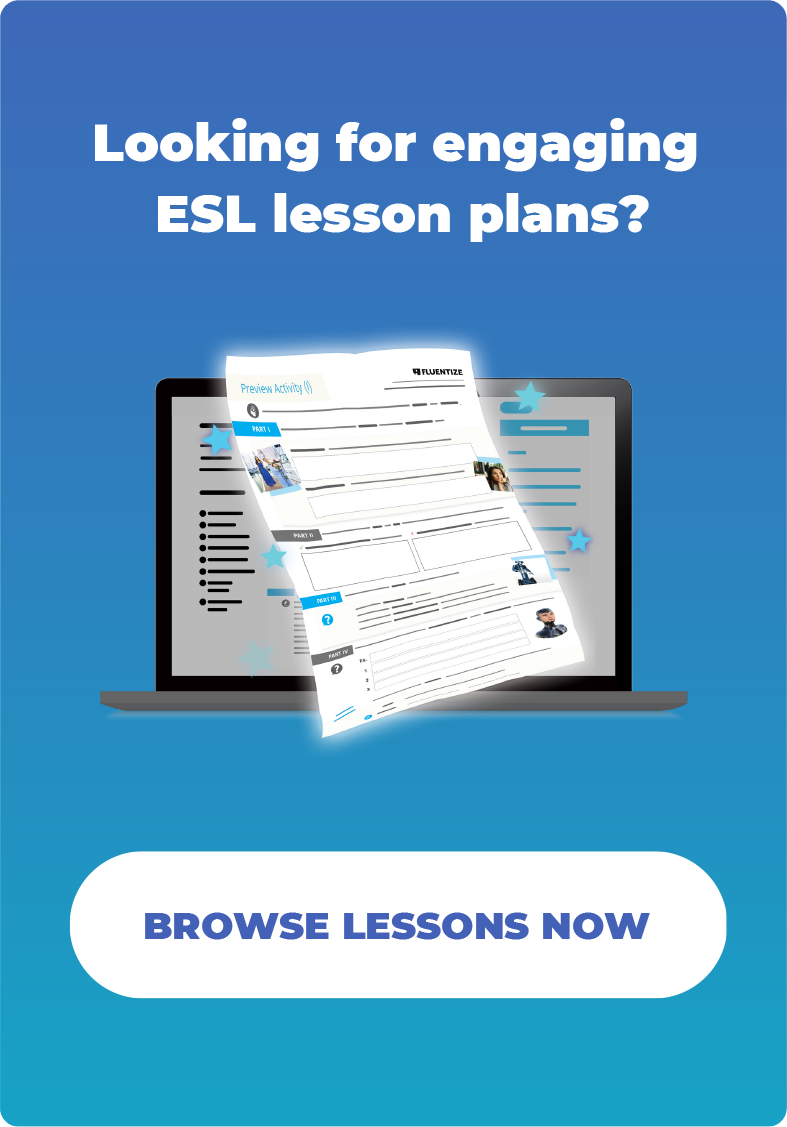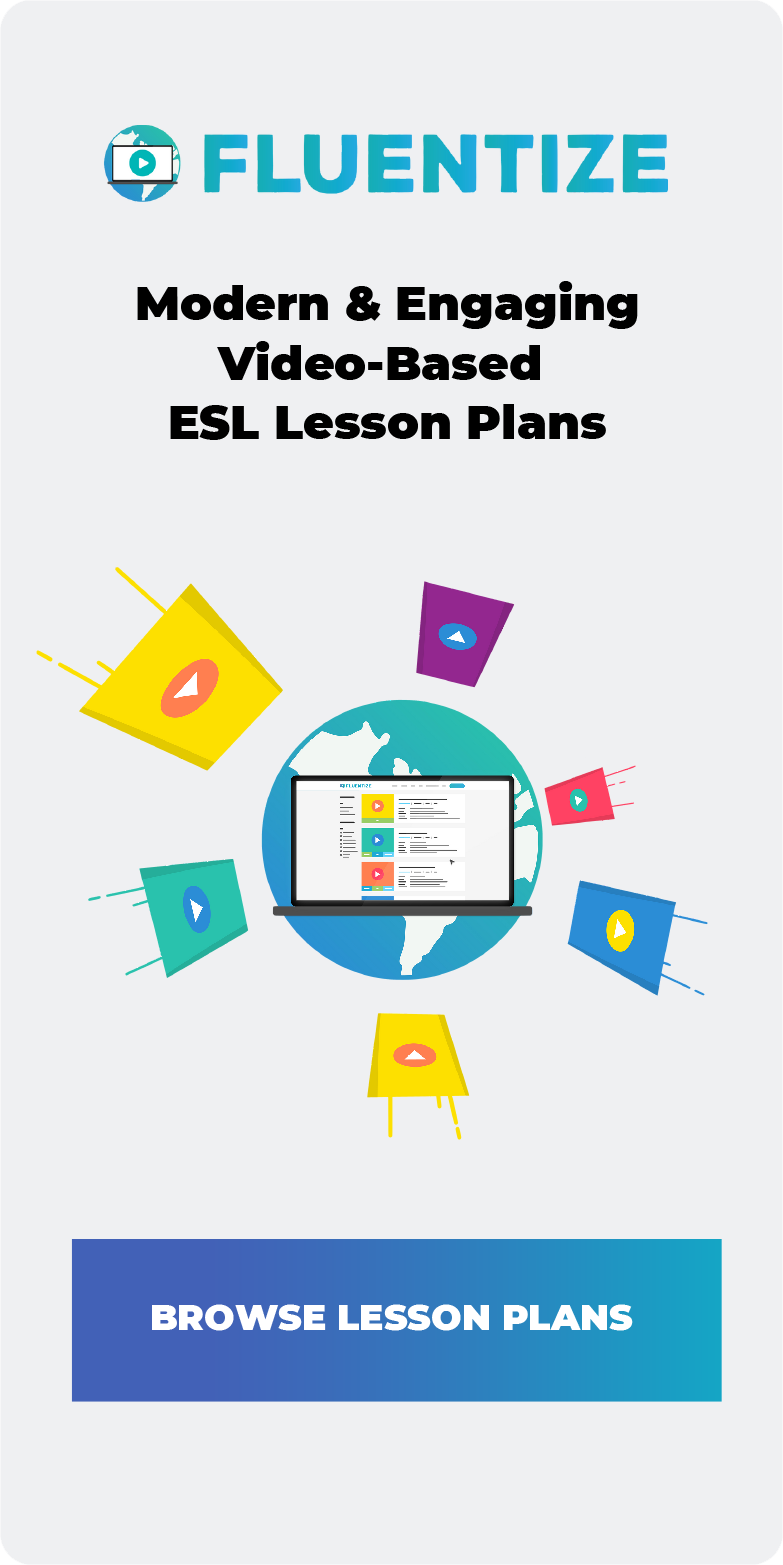If you’re looking for ESL Business English activities to help your students succeed at work, you’re in the right place.
Theo Gold, a famous author, once said:
“Communication is your ticket to success if you pay attention and learn to do it effectively.”
– Theo Gold
This quote alone expresses how important communication skills are. However, communicating effectively can be hard when speaking a second language. This is especially true when it’s about business.
It’s no secret that English language drives global business communication. It’s been the world’s number one language for business for decades. Whether it’s to improve job prospects, manage projects, or make connections, people worldwide need English language for business.
This begs a few questions — how can you help your students communicate effectively in English for business? Which business ESL topics should you focus on? Should you create your own ESL Business English activities? What are some examples of effective activities?
Let’s explore some of these questions.
Should I use pre-made ESL Business English activities, or make my own?
Many teachers already know how time-consuming it can be to write activities for Business English. In many cases, it can even be hard just to know which business ESL topics to use!
Similarly, materials writing takes a lot of practice to master. Creating activities that teach students ESL business communication is hard work. Even if you’re an experienced teacher, materials writing is a skill that takes years to develop.
Therefore, we highly recommend using ESL Business English activities prepared in advance by professionals. Fluentize is a great place to find pre-made lesson materials based on a variety of not only business ESL topics, but also many others. In the end, you’ll not only save tons of time, but also increase impact on students.
Lastly, ESL Business English activities made by resources such as Fluentize are often designed with specific learning outcomes in mind — ones you may not have considered when making your own activities. These can include skills like enhanced negotiation, collaboration, and critical thinking skills.
ESL Business English Activities & Topics by Fluentize
Now, let’s dive into some ESL Business English activities and topics you can use in your own lessons. All of these ideas are taken from Fluentize’s Business English lesson plans, and are all based on an engaging, online video.
You can use these ESL Business English activities in both one-on-one and group lessons, whether they’re online or in-person. All of Fluentize’s business ESL worksheets come in printable and interactive PDF format as well. We also offer lessons in a digital Google slide presentation format.
The activities offered below can be found at the final stage of each lesson. They mostly consist of communicative activities, like role plays, writing tasks, interviews, and more.
1. Teamwork

The ideas offered below are from our lesson plan on teamwork. The ESL Business English activities in this lesson are based on a video featuring called “Teamwords”.
Both the lesson and the game are designed to help students overcome intercultural stereotypes when working in teams.
Simply put, the lesson plan enables learners to collaborate in a meaningful and proactive way. It comes with discussion questions and activities for students to do on teamwork, listed below.
Conversation Questions About Teamwork:
- Do you prefer working in teams or working alone? Why?
- How would you define “good teamwork”? What is the key to good teamwork?
- In what ways can intercultural differences affect teamwork?
- Have you ever worked on an intercultural team? If so, what was it like? If not, what do you think the benefits of working on an intercultural team would be?
Subsequently, students do some vocabulary activities to prepare for the video. After watching the video, students partake in some follow-up discussions that prepare them for the final activity of the lesson described below.
Fluentize’s Communicative Activity On Teamwork:
Step 1: Students work with a classmate (or with you, the teacher, if the lesson is one-to-one).
Step 2: Students discuss and agree on three qualities from a list of traits. These are traits they think are most important when working in a team. Here is a list of traits below you could use:
- transparent
- responsible
- passionate
- approachable
- sincere
- responsible
- reliable
- open-minded
- empathetic
Step 3: Students choose their own job role, or one of five other job roles.
Step 4: Students describe the specific behaviors that someone in this role might demonstrate.
Let’s say that students choose the job role of “marketing manager” from the list of available job roles in the lesson. Then, they should describe their idea of what a “passionate” marketing manager would be like. The objective here is for students to come up with ideas such as:
“A passionate marketing manager gets excited when it’s time to start working on a new advertising campaign and wants to share these ideas with their team. They might start working on the campaign ahead of schedule and answer any questions a team member might have about the campaign thoroughly.”
This activity allows students to find common ground, build bonds, and establish a mutual understanding of different terms.
Check out the full B2-C1 lesson plan on teamwork here.
2. Business Etiquette

Business etiquette is not only essential for making good impressions at work, but creating a professional atmosphere. It encourages people to communicate and carry out their roles effectively.
With that said, this free lesson plan on business etiquette can help your students learn the manners and behaviors expected within the workplace, regardless of the workplace culture or company.
To start, you can have students describe different images of corporate environments.
For example, show students images of people shaking hands, giving good eye contact, or arriving late to a meeting.
After students describe the images, they can do a matching activity on adjectives related to business etiquette. Then, students refer back to some of the images in the first part. Have them use the adjectives to describe the business etiquette in the images.
For example, students match the adjective “appreciated” with its definition — “feeling recognized for your value, worth, or work“.
Then students choose which image shows someone feeling appreciated. For example, the image of people giving each other eye contact during a meeting could match well with “appreciated”.
In addition, here are some discussion questions about business etiquette:
Business English Conversation Questions About Business Etiquette:
- What do you think “business etiquette” means?
- What are some examples of business etiquette?
- How important is it to have correct business etiquette? How can it help you in your career?
- What role does culture play in business etiquette?
- How do you think business etiquette affects productivity in the workplace?
- How should we treat co-workers and colleagues in the workplace?
The lesson plan also includes viewing, listening comprehension, and post-viewing activities based on the video. The most important task in the lesson is the communication task at the end described below.
Fluentize’s Featured Activity On Business Etiquette:
Search and choose images that illustrate specific corporate scenarios, such as:
- Multiple people networking at a convention
- A group of colleagues sitting down at a business lunch
- A person giving a presentation
- An employee and his client having a face-to-face meeting
- An employee and his manager having a virtual meeting
The ones described above are directly from the Fluentize lesson plan.
Step 1: Students choose 2 of the images.
Step 2: Students imagine that something goes wrong in each scenario they chose. They describe what went wrong using adjectives or vocabulary terms related to business etiquette.
You can use the ones below, which are pulled from Fluentize’s lesson plan, or come up with your own.
- appreciated
- bossy
- disrespectful
- uncooperative
- engaged
- polite
- tone
- attention
- handshake
- eye contact
- a good impression
- an active listener
Step 3: Students discuss or share ideas about how the scenarios chose could be improved.
Overall, this activity encourages students to apply proper business etiquette in practical business scenarios they may encounter.
Check out the full A2-B1 lesson plan on business etiquette here.
3. Branding & Marketing

Branding and marketing are great business ESL topics because they interest almost anyone. This is because branding and marketing are all around us, all the time.
In fact, did you know they have a huge impact on our decision-making, behavior, and even identity?
These factors make them relatable ESL topics that can spark interesting conversations in class.
Luckily, all of the Business English ESL activities below can be found in this free lesson plan on branding. If you want to use the full version, we’d like to invite you to do so.
Regardless, here are some activities you’ll find in the lesson.
The first business ESL conversation questions in this lesson focus on comparing some vocabulary terms. See the examples below.
Conversation Questions About Branding:
- What do you think is the difference between a company and a brand?
- What do you think is the difference between branding and marketing?
However, it doesn’t stop there. There are some additional Business English conversation questions based on corporate brands. Give students three examples of major brands, like Nike, Coca Cola, and Apple.
Students then discuss the following questions about these brands:
- What kinds of products does each company sell?
- What is each brand about? How would you describe each brand identity?
- Do you buy their products or support their brands at all? Why/why not?
In the next activity, students have the opportunity to reflect on and discuss some of their favorite brands.
Afterwards, students watch a fascinating, informative report about branding and human psychology.
Then, they complete some listening comprehension activities based on that video, and do some follow-up activities. The main lesson activity is as described below.
Fluentize’s Featured Activity On Branding:
Step 1: Students choose from one of the options below:
- A company/business/organization they established or work for
- A company/business/organization they regularly buy from or support
- A new company/business/organization they would like to create or start
Step 2: Students create a basic company profile for this company, describing the industry it’s in and the types of products or services it sells. Then, students get to create a brand profile, as described below. Have students come up with:
- A description of the brand identity
- A unique selling proposition
- Buzzwords associated with the brand
- A catchy slogan for the brand
Step 3: Students promote/pitch their brand.
- Have students imagine they work for the company/business/organization they chose.
- They imagine they’re meeting with a potential investor (another classmate, or it can be you).
- Students pitch the company and brand using the material they created in Steps 1 & 2 above.
- Students answer any questions their “potential investor” (their classmate or you) has after their pitch.
Not only do these ESL Business English activities put students in real-world scenarios, but they get to practice persuasion skills. These are skills that are important for negotiations, discussions, and presentations. They are also helpful in leadership roles, sales, management, and client interactions.
Check out the full C1 lesson plan on branding here.
4. Vacation & Productivity

Regardless of the job we have, we all need vacations from time to time. The question is, do vacations negatively or positively impact our productivity at work? Mandates on vacation leave vary from country to country, making it an interesting topic to explore in the ESL classroom.
This lesson plan on vacation and productivity explores the connection between vacations and productivity in depth. We’d recommend this lesson for any upper intermediate students who may have an upcoming vacation or just returned from one.
Conversation Questions About Vacations & Productivity:
- Do you have any upcoming vacations planned? If so, where are you going and what are you looking forward to the most? If not, is there any kind of vacation you would like to plan?
- How many days do you take off per year for vacation? Are you satisfied with this number? Why or why not?
- What do you think it means to leave paid vacation time on the table? Why do people do this? Have you ever done this?
After watching an informative report about whether vacations can make you more productive as work, students complete some listening and vocabulary activities.
The featured communicative activity for this ESL business topic is described below. Essentially, it’s a fun role play in which students can use some of the vocabulary terms they learned, including some useful phrases.
Fluentize’s Featured Activity On Vacations & Productivity:
STEP 1: Vacation Planning Task
- Students work with a classmate/teacher.
- They agree on a type of vacation and destination they’d like to go on together.
- They discuss any important details and create some specific plans for the vacation.
STEP 2: Role Play Task
- Students imagine it’s a few days after you plan your vacation together.
- They take one of the roles — Student A or Student B for a role play.
- Students must use at least 3 – 5 of words/phrases below in the role play.
STUDENT A ROLE INSTRUCTIONS:
Call your friend. Tell them you want to back out of your vacation plans due to work-related issues. Explain your situation and a few factors holding you back. Use at least 3-5 phrases below in your call.
- unexpected
- come up
- stress
- get work done
- too much to handle
- a mountain of work
- tune out
STUDENT B ROLE INSTRUCTIONS:
Your friend calls you. They want to back out of your vacation plans. Try to convince them to keep the plans by explaining all the benefits the vacation will give them. Use at least 3-5 phrases below in your call.
- a much-needed break
- lower
- spark
- recharge
- tune out
- vacation days on the table
- productivity
Overall, this activity proves to be an opportunity for students to talk about and make vacation plans, while using a bit of persuasion skills.
Check out the full B1 – B2 lesson plan on vacation and productivity here.
5. Making Offices Happier

According to a study by Forbes, happy employees are almost 20% more productive than unhappy ones.
Therefore, many organizations seek to transform their workplaces to improve employees satisfaction.
Many studies suggest that the ambiance, lighting, and colors in a workspace can alter your mood. Similarly, bringing a plant to work can boost productivity by up to 15%.
If you’re intrigued by these stats, check out this full ESL lesson plan based on offices and making them happier. It covers intriguing ESL business topics like workspace environment, office improvement tips, and greenery in the workplace. It makes for a really interesting B2 – C1 topic.
You can start out by asking students some of the questions below.
Business English Conversation Questions About Offices:
- What is your physical workspace like? Describe it in detail.
- How satisfied are you with the space where you work? What could you do to improve the conditions or make it a happier space to work?
- In general, what kinds of conditions can influence or affect a person’s productivity, creativity, or stress levels in their workspace?
You could then have students compare some images of offices and discuss which ones they would or wouldn’t like to work in. Have them explain why.
Below is the activity that students can do as the main communication task:
Fluentize’s Featured Activity On Offices:
Make sure to assign roles — Student A and Student B. You can take one of the roles if the lesson is one-to-one.
Step 1: Student A thinks about a workspace they want to improve. It can be their actual workplace or an imaginary one. This student should describe the workplace and what’s wrong with it, or some things they don’t like about it.
Step 2: Student A asks Student B (a classmate, or you, the teacher) for some tips ideas to improve it. They should use three words or phrases below when describing the workspace:
- depleted
- worth
- clutter
- greenery
- a sense of + [noun]
- a sort of + [noun]
“There is all kinds of clutter in my office, which makes it really hard to concentrate! I also don’t have enough greenery, which makes it plain and dull. What do you think I should do?”
Step 3: Student B (or you) should then suggest some ideas on how they could improve their workspace and explain why these ideas could help.
Student B (or you) should also use three words or phrases highlighted below while giving suggestions.
- biophilia
- harmonious
- bright
- disciplines
- an element of + [noun]
Example:
An example may look something like this:
“That’s great that you’re considering implementing some biophilia into your office environment. Studies show that it can increase productivity. It will also add an element of comfort. You could also try moving your office to a brighter part of your home. This could help your plants grow and create a better atmosphere for creative thinking.”
This allows students to practice giving suggestions while learning some interesting vocabulary terms related to offices.
As a result, this can help students increase their productivity and inspire them to make positive changes in their work lives.
Check out the full B2-C1 lesson plan on offices here.
6. Writing Emails: ESL Business English Activities

Email is the primary channel of ESL business communication across most industries. Understandably, this makes email writing a trendy ESL Business English topic to cover.
Using this lesson plan on writing effective business emails, you can train your B2 students how to use proper formats, communication etiquette, and clarity when writing emails.
But first, you can use some of the ESL Business English conversation questions below about emails.
Business English Conversation Questions About Emails:
- How important is email communication in your work life?
- What are the advantages and disadvantages of email communication?
- How soon should you respond to a work email? Explain your answer.
- What are some good tips to follow for business email etiquette?
Fluentize’s Featured Activity On Writing Emails:
Come up with your own email, or share the sample email below from a company team manager to team members. The idea here is to use bad email etiquette (as an example of what you shouldn’t do):
Email Subject Line: I should remind you that there will be a team-building event coming soon
I think outdoor team-building events are good for companies. Team building events can be more successful if there are outdoor activities planned. There will be volleyball, soccer, and rock climbing at the event. I personally love rock climbing, and I’ve been doing it for a few years. Unfortunately, I forget what other types of activities there will be exactly. I hope that everyone on our team can come to the event. The event is at a local recreation center. I’m not sure if food and drinks will be provided at the event. The event is not mandatory to attend.
Cheers,
Step 1: Students discuss what’s wrong with the email based on the tips from the video and what they learned from the video and lesson.
You want students to identify the following issues, such as:
- There is no call to action in the email.
- The sender also didn’t state that they attached something.
- They ramble in the email.
- There is no farewell.
- The subject line isn’t concise.
Step 2: Students suggest changes to improve the email etiquette.
Step 3: Students rewrite the email using their own feedback to make it better than the original.
And then, of course, have students rewrite this email based on their own feedback. This activity is an ideal way for students to practice email writing while developing important email etiquette!
Check out the full B2 lesson plan on writing emails here.
7. Conversation Skills

Conversations skills are an essential part of workplace communication.
Not only are conversation skills useful for small talk, but also sharing information, giving advice, or building relationships with colleagues.
In light of this, ESL teachers can help B1 – B2 learners improve their conversational skills by using this lesson plan about conversations. It provides a gamified experience in which students play “the conversation game”, as described below.
To start the lesson, you can ask students some conversation questions below about conversations.
Yes, you read it right — conversation questions about conversations!
Business English Conversation Questions About Conversations:
- How would you define or describe what a good conversation is?
- What should / shouldn’t you do during a conversation with someone? Why?
- Do you know what a follow-up question is in a conversation? Why is it important to ask follow-up questions in a conversation?
At the end of this Fluentize lesson, you can find a role play designed for students to play the conversation game.
Fluentize’s Featured Activity On Conversations:
Step 1: Assign roles — Student A and Student B. The teacher can take one of the roles if the lesson is one-to-one.
Step 2: Student A asks their partner about what they’ve been up to lately. They must ask 3 follow-up questions based on the responses they get from Student B.
Step 3: After answering the third question, Student B turns the conversation back to Student A and asks them some questions.
Let’s take a look at an example, which you could demo for students before doing the activity.
- Student A: So, Stan, what have you been up to lately?
- Student B: I actually just got back from a camping trip last night.
- Student A: Oh, really? Where did you go?
- Student B: We went to Harriman State Park, which is about a 45-minute drive outside of the New York City area.
- Student A: I’ve never heard of that park. Do you recommend this location for camping?
- Student B: It’s not bad, but I’ve been to better locations.
- Student A: Oh, ok. What didn’t you like about it?
- Student B: The lakes in the area weren’t so clean, and we were really looking forward to swimming. What about you? Do you ever go camping?
Afterwards, you can simply switch roles and repeat. This is a very effective activity to help students practice natural conversation skills and ask follow-up questions.
Check out the full B2 lesson plan on conversation skills here.
8. Job Searching

As we’ve already discussed, English Language skills play a significant role in landing a job.
If you have pre-intermediate students, a lesson plan on job searching might be a great option for them. This particular lesson is based on an engaging LinkedIn commercial.
First, you can get students discussing some of the questions below.
Conversation Questions About Job Searching:
- For what reasons do people change jobs?
- Where are the best places to look for a job?
- How have you found jobs in the past?
Students then watch a short LinkedIn commercial that comes with a listening exercise. Afterwards, they’ll do some follow-up vocabulary activities.
However, the main language focus of the lesson is based on relative pronouns. This is because in the video, relative pronouns are found in these quotes:
EXAMPLE 1: “I’m searching for a job where I’m in charge.“
EXAMPLE 2: “I’m searching for a job that doesn’t feel like work.“
In the lesson materials, students do some exercises on these relative pronouns, and then move on to the final dialogue activity described below.
Fluentize’s Featured Activity On Job Searching
The first step is to assign roles — Student A and Student B. If the lesson is one-to-one, you can take one of the roles.
Student A asks Student B (a classmate or you, the teacher) what their (or your) current job is like, followed by asking about their (or your) dream job.
Below is a sample conversation:
- Student A: What is your current job like?
- Student B: Currently, I have a very boring job. I sit behind a computer all day, and I don’t talk to anyone.
- Student A: What is your dream job?
- Student B: My dream job is a job where I can be more active and socialize with others.
In this particular lesson, the idea here is for students to use the relative pronouns that/where when responding to their classmate’s question. Using relative pronouns here is a very natural way to discuss the kinds of work we want and prefer. This is a particularly useful grammar point and exercise to use with students who may be looking for new work.
All in all, this type of Business English activity provides students the opportunity to use grammar while also talking about their own jobs and dream jobs.
Check out the full A2 lesson plan on job searching here.
9. Networking

In the business world, it’s all about connections. And in business today, building rapport with others in English is key to career advancement.
ESL Business English activities that mimic real-life scenarios such as networking role plays can train students to make connections in various social contexts.
With this in mind, let’s dig into this lesson plan here about networking, ideal for B1 – B2 intermediate students. You can start the lesson by having students discuss some of the questions below about networking:
Conversation Questions About Networking:
- To what extent do you network in person or online for your job/profession?
- Where are the best places to look for a job?
- How have you found jobs in the past?
After a few more preview activities about networking, students watch a video about how to make connections in the workplace.
The main language focus of this lesson is on phrases and phrasal verbs connected to the topic of networking, such as:
- to break the ice
- to bring [something] up
- to give a business card out
- to follow up with someone
Students move on to use some of these phrases and phrasal verbs in action in the communicative activity described below.
Fluentize’s Featured Activity On Networking
Step 1: Assign roles — Student A and Student B. The teacher can take one of the roles if the lesson is one-to-one.
STUDENT A:
- Introduce yourself and break the ice.
- Ask Student B what brings them to the event.
- Bring up the topic of jobs and ask Student B about their experience and skills.
- Listen empathetically and respond with curiosity.
- Try to find common ground and make a genuine connection.
- Ask Student B for their business card.
STUDENT B:
- Respond to Student A’s ice-breaker.
- Introduce yourself and tell Student A what brings you there to the event.
- Bring up the topic of jobs and ask Student B about their experience and skills.
- Describe your job experience and skills after they ask.
- Try to find common ground and make a genuine connection.
- Give out your business card (pretend to give it out).
This is a very effective activity for students to practice their networking skills in English language and making connections.
Check out the full B1 – B2 lesson plan on networking here.
10. Career Success

The topic of career success in ESL lessons is important because it addresses a fundamental part of students’ lives.
In a lesson about career success, students can talk about their career paths and successes they’ve had. This is important because it helps them reflect, share their dreams, and celebrate their accomplishments.
In light of this, we’d like to share a lesson focused on career success, and is suitable for B2 – C1 advanced students. This particular lesson begins with students talking about success in general:
Conversation Topics About Success:
- What does success mean to you?
- What do you think is the secret formula to success?
- What are traits or skills necessary to achieve success?
Students then complete a few more vocabulary and discussion activities to prepare for the video. After watching a video about a woman describe her career path, students complete some follow-up activities.
The main focus is on phrases and phrasal verbs related to success, as well as some parts of speech. Students will use these in a communicative activity as described below.
Fluentize’s Featured Activity On Career Success
Step 1: Students write the titles or names of some jobs they’ve had in the following categories:
- Their first job
- A job during high school (or between 13 – 18 years old)
- A job during university (or between 18 – 24 years old)
- A job after graduating university (or in their mid to upper 20s)
- Any other job(s) in their life that they’d like to talk about
Step 2: Students take turns sharing their career path stories with a classmate or the teacher.
- Their highlights, successes, or what they excel/have excelled in their career or jobs
- Which of their jobs was a huge jump for them, if any, and why
- Who they answer/answered to in the jobs they have/have had
- Any times that they’ve screwed up or failed in their career path or jobs
- Valuable lessons they’ve learned or challenges they’ve faced in their career path or jobs
Step 3: Students discuss which of the following traits/skills below were important to have or learn in their jobs, among some others.
- persistence
- accountability
- resilience
- self-reliance
- adaptability
This type of communicative business English activity on success is an engaging and relatable way for students to share their own experiences. It gives them the chance to practice important language and use phrases, phrasal verbs, and other vocabulary related to career success.
Check out the full B2 – C1 lesson plan on success here.
Final insights on teaching ESL Business English activities and topics
With so many business ESL topics and activities to choose from, it can be tough to navigate for both teachers and students.
In any case, we hope you’ve found our list of ESL Business English lesson activities and topics inspiring and useful.
After all, effective business communication is the key to establishing, managing, and sustaining long-term relationships in any workplace. By helping your students improve their English proficiency for work, you can have a great impact on their job and career success.










3 thoughts on “10 Top-Notch ESL Business English Activities & Topics”
Credit to the group at Fluentize! Your foundation reliably conveys first class assets and exercises for ESL students, making language procurement drawing in and viable. The quality of the content is truly commendable, and the assortment of topics and activities cater to various learning styles. Much obliged to you for being a go-to asset in the language learning local area!
We really appreciate that feedback! That really pleases us to hear that our materials have been a valuable resource for you. Thanks for using our lessons and we hope you continued success with your students.
This blog is incredibly informative and practical, providing engaging and valuable insights for ESL learners.